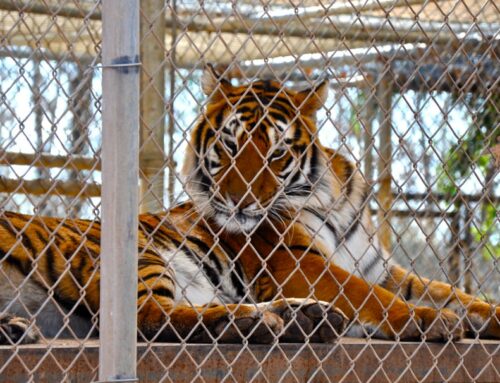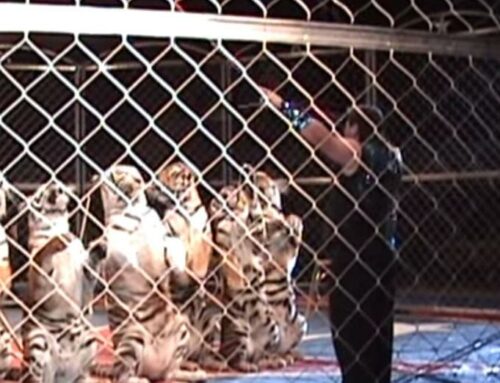Inbreeding at Brown’s Oakridge Zoo Results in White Tiger
SMITHFIELD – There is big news at Brown’s Oakridge Zoo.
A white Siberian male tiger cub was born at the zoo on Sept. 8. The cub has been named Bogdan which means “Gift of God” in Russian.
At birth, Bogdan weighed a mere 1.5 pounds. Now, he weighs in at 6 pounds and has a good appetite.
White tiger cubs typically have an 80 percent mortality rate, so the celebration of this new addition is especially great for zoo owners Nancy and Ivan Brown.
“He is a blessing to us. In the wild he would have died,” explains Nancy of her precious gift.
The zoo has the only white Siberian tiger exhibit in the state of Illinois and has been the only family-operated zoo in the state for the last 21 years.
Nancy explains the sad part of the story is that the cub’s mother died, due to complications of the birth. A second tiger cub was stillborn. “That makes him (Bogdan) very special to us,” remarks Brown, who said it was remarkable that he went to a bottle within six hours of his birth. Bogdan will not be able to see until he is about six weeks old and the Brown’s are anxious to see if his eyes remain blue, or turn to brown just like his mother’s eyes.
Most people think a white tiger is a Siberian, but that is not accurate, says Nancy. Subspecies of tigers can also be white in color.
“The white tiger started years ago with a white tiger being captured in the wild and brought into captivity in India,” says Nancy, who has done her homework.
That tiger “Mohan” was bred to his daughters, grand daughters, nieces, and so on, explains Brown of the linage. With such a long line of inter-breeding, there is an 80 percent mortality rate in the cubs which also can suffer with scoliosis and respiratory problems. “We are fortunate to have a healthy cub. There have been no other white tigers found in the wild since Mohan,” Nancy emphasizes. She explains experts in the field expect wild tigers to be extinct in a generation. There are less than 200 Siberian tigers in the wild, currently.
The Browns have raised exotic animals at their rural location for over 30 years. “We have rescued quite a few animals over the years from various situations,” says Nancy. The zoo, family owned and operated since 1990, started out with a single pot-bellied pig and a few whittle deer.
The zoo currently has an expectant lion and leopard. Nancy says the cubs will be born this fall.
Currently, the zoo has over 40 different species of animals – some are endangered species. Visitors can find lions, tiger, bears, leopards, cougars, bobcats, wolves, a kangaroo, and much more.
Zoo animals are feed approximately 150-200 pounds of meat per day, 50 pounds of dog food, 50 pounds of grain, 100 pounds of hay, and other specialty feeds for some of the animals.
The zoo is located southwest of Smithfield, Ill., at 17732 N. Dairy Farm Rd. Hours are 10 a.m. until 4 p.m. Monday through Saturday and noon until 4 p.m. on Sunday. The zoo opens on May 1 and continues those hours until Labor Day.
After Labor Day, the zoo is open on weekends from 10 a.m. until 4 p.m. on Saturday and from noon until 4 p.m. on Sunday. Appointments are taken from those wishing to the visit the zoo during the week.
During Spoon River Scenic Drive on Oct. 1, 2, 8 and 9, the zoo will be open from 9 a.m. until 6 p.m. Visitors will be allowed to feed the big cats, bears, and hoof-stock animals. They can also have their photo taken with Bogdan the new white Siberian tiger cub.
Nancy says, “We have turned our home and land into a place where we can promote and help to insure the future existence of animals, some of which are endangered. We are dedicated to the animals and want to provide them with a safe place to live in a stress-free environment. Our work is a labor of love and we truly love what we do.”
In addition, the Browns say they just want to bring happiness to their visitors.
The Browns have learned through hands-on experience and have studied to keep abreast of information on their animals.
The zoo is visited by people from throughout the United States each year. Some tell Brown they are fulfilling a lifelong dream to see a certain species, or to pet a wild animal. No matter what the reason, Brown has many interesting stories to tell about her animals and their visitors.
The zoo is solely supported by admission, photo fees, and donations. The zoo travels with offsite exhibits to schools, nursing homes, libraries, camps, birthday parties, business promotions, and provides educational programs throughout the state.






Leave A Comment
You must be logged in to post a comment.